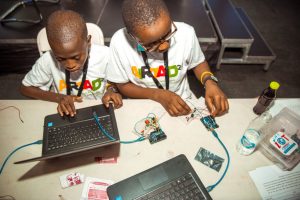By Olivia Serwaa Opare
Accra, Dec. 03, GNA – In recent years, there has been a growing emphasis on promoting STEM (Science, Technology, Engineering, and Mathematics) and STEAM (Science, Technology, Engineering, Arts, and Mathematics) education.
These disciplines are crucial for developing critical thinking, problem-solving, and innovation skills in students. While schools play a significant role in STEM/STEAM education, the home environment can also serve as a catalyst for fostering a love for these subjects.
This article explores various ways in which parents and caregivers can utilise the home to promote STEM/STEAM learning and teaching.
Create a STEM/STEAM-friendly environment:
Transforming the home into a STEM/STEAM-friendly environment can inspire curiosity and exploration. Set up a designated area for experiments, projects, and hands-on activities. Stock it with age-appropriate books, puzzles, building blocks, art supplies, and scientific tools. Encourage children to engage in open-ended play and exploration, allowing them to develop their creativity and problem-solving skills.
Encourage inquiry-based learning:
Encourage children to ask questions and seek answers.Eg.How is day and night formed? Foster a culture of curiosity by engaging in discussions about scientific phenomena, technological advancements, engineering marvels, and mathematical concepts. Encourage children to explore their interests and find answers through research, experiments, and discussions.
Integrate STEM/STEAM into everyday activities:
Incorporate STEM/STEAM concepts into daily routines and activities. For example, involve children in cooking and baking, buying and selling,which can teach them about measurements, chemical reactions, and nutrition. Gardening can provide opportunities to learn about biology, ecology, and environmental science. Encourage children to observe and document their findings, fostering scientific inquiry.
Utilise technology and online resources:
Leverage the power of technology to enhance STEM/STEAM learning at home. There are numerous
educational websites, apps, and online platforms that offer interactive lessons, virtual experiments, coding tutorials, and more. Encourage children to explore these resources under parental guidance, ensuring a balance between screen time and hands-on activities.
Engage in STEM/STEAM projects and challenges:
Encourage children to undertake STEM/STEAM projects and challenges that align with their interests. This could involve building a model, designing a simple machine, conducting experiments, or creating artwork inspired by scientific concepts. Such projects promote critical thinking, problem-solving, and collaboration skills.

Foster collaboration and teamwork:
Encourage children to work together on STEM/STEAM projects with siblings, friends, or parents. Collaboration fosters communication, teamwork, and the exchange of ideas. It also provides an opportunity for children to learn from each other and develop social skills.
Connect with STEM/STEAM professionals and organizations:
Explore opportunities for children to interact with STEM/STEAM professionals, such as scientists, engineers, artists, and mathematicians. Attend science fairs, exhibitions, workshops, or invite guest speakers to share their experiences and insights. Engaging with real-world practitioners can inspire children and provide them with role models.
In circling back, the home environment can serve as a powerful catalyst for promoting STEM/STEAM learning and teaching.
By creating a STEM/STEAM-friendly environment, encouraging inquiry-based learning, integrating STEM/STEAM into everyday activities, utilising technology and online resources, engaging in projects and challenges, fostering collaboration, and connecting with professionals, parents and caregivers can nurture a lifelong love for these disciplines in children.
Emphasising STEM/STEAM education at home will equip children with the skills and mindset necessary to thrive in an increasingly technology-driven world.
GNA

The writer is the Director of Science Education Unit, Ghana Education Service.